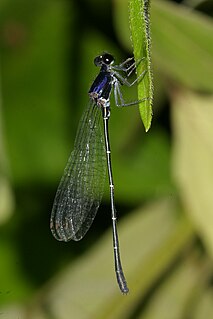The Badakhshana rock agama is an agamid lizard found in NE Afghanistan, N Pakistan, Kashmir, China (Xinjiang), SE Turkmenistan, eastward through Tajikistan to W Kyrgyzstan.

Triplophysa is a genus of fish in the family Nemacheilidae found mainly in and around the Qinghai-Tibet Plateau in China. Currently, the genus is a mixed assemblage of species. Some lineages have been identified and treated as subgenera, but as Wikipedia follows Fishbase for fish species these have been treated as subgenera in Wikipedia, although Kottelat and the Catalog of Fishes treat them as genera. FishBase, however, includes these in Triplophysa without specifying subgenera and treats the names given by Kottelat as synonyms.
Drepanosticta is a genus of damselfly in the family Platystictidae. Some authors consider some species to be in the genus Ceylonosticta.

Elattoneura is a genus of damselflies in the family Platycnemididae.
Paleontology or palaeontology is the study of prehistoric life forms on Earth through the examination of plant and animal fossils. This includes the study of body fossils, tracks (ichnites), burrows, cast-off parts, fossilised feces (coprolites), palynomorphs and chemical residues. Because humans have encountered fossils for millennia, paleontology has a long history both before and after becoming formalized as a science. This article records significant discoveries and events related to paleontology that occurred or were published in the year 1997.
The Chloroflexi or Chlorobacteria are a phylum of bacteria containing isolates with a diversity of phenotypes including members that are aerobic thermophiles, which use oxygen and grow well in high temperatures, anoxygenic phototrophs, which use light for photosynthesis, and anaerobic halorespirers, which uses halogenated organics as electron acceptors.

Deinococcus is one genus of three in the order Deinococcales of the bacterial phylum Deinococcus-Thermus highly resistant to environmental hazards. These bacteria have thick cell walls that give them Gram-positive stains, but they include a second membrane and so are closer in structure to Gram-negative bacteria. Deinococcus survive when their DNA is exposed to high doses of gamma and UV radiation. Whereas other bacteria change their structure in the presence of radiation, such as by forming endospores, Deinococcus tolerate it without changing their cellular form and do not retreat into a hardened structure. They are also characterized by the presence of the carotenoid pigment deinoxanthin that give them their pink color. They are usually isolated according to these two criteria.

Onychargia atrocyana a species damselfly in the family Platycnemididae. This species is commonly known as the marsh dancer or black marsh dart. It is found in Asia: Bangladesh, China, Hong Kong, Indonesia, India, Sri Lanka, Myanmar, Malaysia, Philippines, Peninsular Malaysia, Singapore, Thailand, Viet Nam.

Fortis Healthcare Limited (FHL) is a chain of hospitals, headquartered in India.
Echo is a genus of damselflies belonging to the family Calopterygidae. There are five species. A sixth, Echo maxima, is sometimes included, but it probably belongs to a different genus.

The Perilestidae are a family of damselflies commonly known as shortwings and twigtails. It is a small family of around 19 species. All extant species are native to the Neotropic ecozone. In the past Nubiolestes of Africa was included in this family, but this is doubted. Palaeoperilestes electronicus is an extinct species described from mid-Cretaceous Burmese amber.

Gongpoquansaurus is an extinct genus of basal hadrosauroid dinosaur that was not formally named until 2014, while the name was a nomen nudum for many years previously. It is known from IVPP V.11333, a partial skull and postcranial skeleton. It was collected in 1992 at locality IVPP 9208–21, from the Barremian Zhonggou Formation, in Mazongshan, Gansu Province, China. The specimen was first described and named by Lü Junchang in 1997 as the third species of Probactrosaurus, Probactrosaurus mazongshanensis. Following its description, several studies found it to be less derived than the type species of Probactrosaurus in relation to Hadrosauridae. Therefore, "Gongpoquansaurus" had been suggested, yet informally, as a replacement generic name. In 2014, the species was formally redescribed, and the describers erected Gongpoquansaurus.
This article contains papers in paleobotany that were published in 2016.

Coeliccia is a genus of damselflies in the family Platycnemididae. They are distributed in Asia from India to Japan to Indonesia. It is the largest genus in the family, with over 60 species.
Idiocnemis is a genus of damselflies in the family Platycnemididae. They are distributed on New Guinea and the surrounding islands. There are 20 species.
This list of fossil arthropods described in 2017 is a list of new taxa of trilobites, fossil insects, crustaceans, arachnids and other fossil arthropods of every kind that are scheduled to be described during the year 2017, as well as other significant discoveries and events related to arthropod paleontology that are scheduled to occur in the year 2017.
The giant velvet worm is a species of velvet worm in the Peripatopsidae family.
Polynucleobacter sinensis is an aerobic, chemo-organotrophic, catalase- and oxidase-positive, free-living bacterium of the genus Polynucleobacter, isolated from a freshwater pond in China. The species represents planktonic bacteria (bacterioplankton) dwelling in non-acidic freshwater systems. The species name refers to the origin of the type strain from China.
Roseomonas is a genus of Gram negative bacteria. The cells are coccoid rods when viewed microscopically. Certain species are known to be opportunistic infections for humans.











